 There are a wide range of attitudes and perspectives around the issue of teachers unions, and the effects these unions have on our children’s learning. As with most political circumstances, a healthy balance of agreement and disagreement are needed in order to fully appreciate and comprehend the various sides to the issue(s) at hand. All too often, impassioned and well-meaning individuals can take a stance that is very definitive, faulting a singular source as the blame for a much larger, systemic issue – such as the case in the US gun ownership argument, for instance.
There are a wide range of attitudes and perspectives around the issue of teachers unions, and the effects these unions have on our children’s learning. As with most political circumstances, a healthy balance of agreement and disagreement are needed in order to fully appreciate and comprehend the various sides to the issue(s) at hand. All too often, impassioned and well-meaning individuals can take a stance that is very definitive, faulting a singular source as the blame for a much larger, systemic issue – such as the case in the US gun ownership argument, for instance.
In the case of teachers unions, there are avid supporters and cynics. I do not believe any teacher, administrator, legislator, or other public official would intentionally deteriorate or be a disservice to the educational system. In my view, all efforts to address the issue of failing schools/students and educational woes are made in good faith, but sometimes by individuals or groups without sufficient understanding of a school system and particular case scenarios, and without a fundamental ability to anticipate unexpected consequences of a give action/reform.
The education challenges this nation faces can be broken down into well-defined sources:
- A rising population of:
- Non-english-speaking students
- Special education students
- Low-income families
- Decreases in funding from Title I, IDEA, and other federal and state-funded education programs that have provided support for several years (decades in some cases)
- Lack of discretionary funding at the lowest level – classrooms
- Continued pressure on schools to accommodate more students, provide more non-traditional services, and educate all students to the same proficiency levels
The additional efforts required with an increasing population of non-native English speakers is exhaustive. Outside of the classroom, teachers must be able to interface with parents/guardians of the children in order to provide the same level of interaction as with traditional students – something which can be more challenging than working with the students themselves. Unreasonable expectations have been set forth on educators to facilitate classes with a mix of English-proficiency students, with the goal to have them come out of the classroom at the same level as their peers. The different models for educating ELL students that we reviewed are an example of how delicate and personal of an issue this is, and just how many ways there are to provide directed services aimed at improving these students’ capacities. There is no one answer for this issue, and these students must be accommodated on a case-by-case basis, where often times the teachers, parents, and administration are the only ones capable of making the best decisions for their children.
Special education students present similar challenges for educators as ELL students, in that there are many ways to provide directed services for them, never enough resources or educators/supporters to go around, and a demand for case-by-case support that often times cannot be met by the schools and teachers.
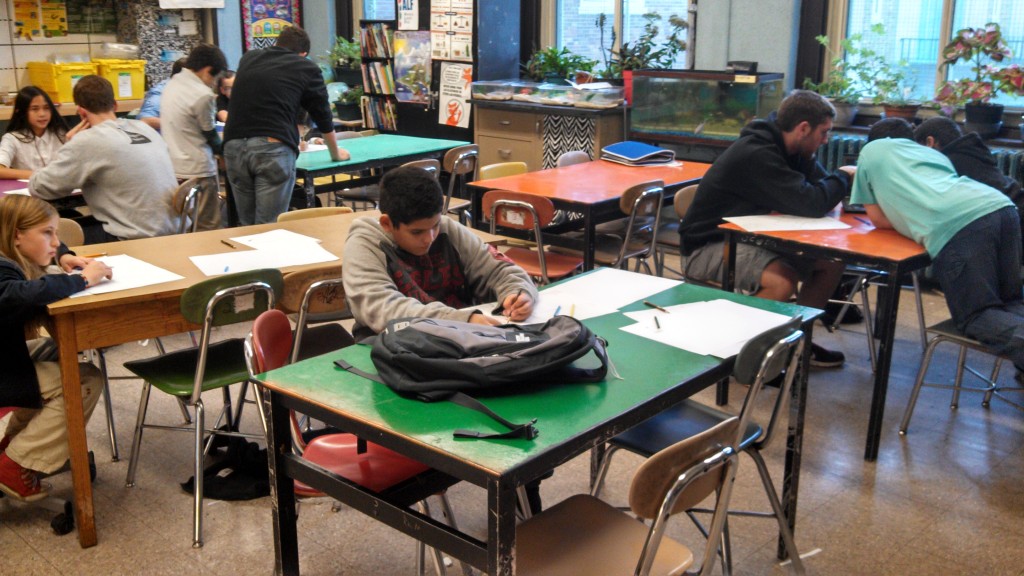 Decreases in funding programs and both financial and in-kind support for schools can be both easy and difficult to measure. When there is a dip in funding, less programs are offered to the students, less teachers are employed, and less resources are available. These are easily measurable, quantifiable downturns that lead to very quantitative impacts; higher class sizes, less discretionary funding for classroom resources, less field trips and extracurricular offerings, etc. In some cases, the effects of losing some support programs are less evident; less support staff or community engagement, less professional development opportunities for educators and administration, etc. In any given year, teachers and administrators must balance their resources and support without becoming overly-dependent on any one program, individual, or source of funding – since you never know how long they will truly last. The year-to-year support (financial and service) is so volatile in some schools that it makes it nearly impossible for the school to have sustained growth. I think any program supporting a school and its students should be in place for no less than 5 years, with defined entry and exit strategies and sustainability plans that will leave the school stronger upon completion.
Decreases in funding programs and both financial and in-kind support for schools can be both easy and difficult to measure. When there is a dip in funding, less programs are offered to the students, less teachers are employed, and less resources are available. These are easily measurable, quantifiable downturns that lead to very quantitative impacts; higher class sizes, less discretionary funding for classroom resources, less field trips and extracurricular offerings, etc. In some cases, the effects of losing some support programs are less evident; less support staff or community engagement, less professional development opportunities for educators and administration, etc. In any given year, teachers and administrators must balance their resources and support without becoming overly-dependent on any one program, individual, or source of funding – since you never know how long they will truly last. The year-to-year support (financial and service) is so volatile in some schools that it makes it nearly impossible for the school to have sustained growth. I think any program supporting a school and its students should be in place for no less than 5 years, with defined entry and exit strategies and sustainability plans that will leave the school stronger upon completion.
The last source of pressure on schools and educators has come gradually, indirectly through the downturn of other services often provided outside of the schools; health services, counseling, adult education programs/support, and other non-traditional services that are more and more often being demanded at schools.
While these sources do not exactly address the issue of teachers unions, I believe they are an important predecessor in outlining how to best address the educational challenges that we currently face across the nation. Teacher’s unions are often blamed for the failing student populations, lack of discernible improvements made over the course of a semester or year, and for just about everything else that a teacher has a hand in doing. While I would agree there are many faults with the unions in general, it is clear that the systemic social problems are at the root of the overall failings in the educational system. No teacher, unionized or not, paid $100,000 or $40,000, can independently solve the overarching failures of the communities and national society that currently exists.
In order to stem the decline of the US school system, the first issue to address is a national pre-K program, and support/services to the most disenfranchised new parents and families in the urban and rural areas across the US. If a child is not afforded the growth and nurturing necessary in the first three years of their lives, they will be forever at a disadvantage and their ability to learn and grow will be forever stifled. A child entering any grade below the capacity of their peers will not only suffer personal determinant, but also carries the risk of bringing his or her peers down with them – through no fault of their own, I might add, but simply through natural tendencies (nobody wants to be alone, after all).
There also exists a strong inclination for ‘top-down’ solutions; national and state-wide frameworks, district-directed curriculum plans, state-wide evaluation metrics, etc. As Wagner has expressed, there seems to be little confidence and mobility for educators on the bottom level to ‘innovate’ in the classroom. Any teacher can know when a lesson is going badly, and when students do not develop an understanding of the concepts. It takes a special individual, and often times a team of individuals, to take a lesson apart and figure out just how to properly scaffold, integrate cross-curriculum concepts, and provide self-learning opportunities for students to truly engage in and develop a deep understanding of the content. But without any discretionary funding to buy supplies, show videos, bring in guests, and take field trips, the teachers are stifled and complacent. They do the lessons, they go home, and they don’t reflect or build off of their successes and failures.
Evaluations: If you ask a class if their teacher is good, you’ll likely get a pretty reasonably-accurate assessment. If you ask a parent how much contact the teacher has with them, how much homework their student gets and of what level of difficulty, and if they believe the teacher is actively engaged in their individual child’s growth, you will likely get a pretty reasonably-accurate assessment. If you ask the teacher’s peers and supervisors how they think the teacher performs, you can likely get a pretty-reasonable assessment. If you examine directed* test scores for students at the beginning and end of a semester, you can likely get a good understanding of how the students content knowledge has improved over the course of the year.
As Wagner noted, there must be a higher level of support and interaction between teachers and the administration. Principals and specialists must sit in on classes as frequently as possible. Other teachers must share lesson plans, resources, and advice, and must also observe and support each-other. At the University level, this collaboration is not only accepted by demanded. Faculty do not usually sit-in on others’ classes, however they are very actively engaged in supporting each-other’s lesson planning, curriculum development, and supporting activities – both between and across colleges/disciplines. Such collaboration must be nurtured and supported at the K-12 level. There are many individuals and schools that already excel in this support and feedback system, however there must be both a bottom-up and top-down drive to initiate and structure such teamwork. Videotaping classes, group feedback sessions, structured professional development opportunities, and open-discussions are, in my opinion, a must for each teacher and school – both internally between disciplines and externally among all teachers at the school and other schools in the district. So many K-12 educators operate strictly within their own individual silo, too engrained in their own work to realize the opportunities for support right across the hall. Often times, teachers hardly will even speak with one-another, even those teaching the same content areas.
On the subject of seniority, teacher performance, and the tenure-track that secures teachers a strong foothold in their job; such a system did once exist in the US, though on not such a formal basis. For-profit companies would (and still do) favor seniority, performance, and dedication. But when a better-suited employee comes around for a job, the company is generally going to hire the most-capable candidate, and will fire the worst-performing or most dispensable employee. In the public education system, there are teachers who are in the school not because they love to teach, but because it became their job and now they do it because it is ‘all they know’. We have thousands of students that graduate college each year that have a great desire to be actively-engaged teachers. They are (generally) well-educated, have the current technological comprehension/abilities, and are aware of trends, child expectations and changing social settings that some of the more senior educators may not be as in-touch with. This is not to say they are or would be better teachers, but just that they exist and have a strong desire to be in the classroom. Some teachers quite frankly do not like teaching, have grown out of the role, but continue to teach since there is little mobility to transfer to another career path or role. These teachers may still perform well, but will never go above and beyond the call of duty. They don’t show up for the extracurricular school offerings, the special events, or the student’s performances and the students are subtly aware of this. The administration is also aware of this disinterest. While I agree with Diane Ravitch that we “don’t have a problem with ‘bad teachers’”, I think there are still many teachers who should find other gainful employment, retire, or play a role of ‘support’ for the younger generation of educators eager to embark on a career in the classroom. A school principal and staff are well aware of who the teachers are that are only ‘in it for the job’, and those which the school could stand to lay-off. While the teacher’s union supports working rights of educators, the unions’ ultimate missions are for improving student education. In the coming years and decades, the unions must actively promote health conversation and collaboration between members, between teachers and school administrators, and between teachers and families. There are only a few teachers that should be fired, and it is ultimately a bigger battle to fire them then to let them ‘run their course’. The bigger, more sustained effort should be focused on cultivating a sustainable, collaborative and interactive community within each school and each teacher/administrator.
I had an idea that teachers should be paid a rate based on the difficulty-level of the school within the district; a low-performing school would pay an incoming teacher more than they would receive if they signed at a higher-performing school, with the expectation that the higher salary would require longer working-hours, increased support/services for their students, and additional PD and team meetings/collaboration. Teacher pay is an incredibly difficult issue; should it be based on subject content taught, years of experience, content knowledge (STEM, languages, etc), location, student population, etc. There is no singular answer to this issue, and it must be addressed on a district-by-district basis. My feeling is that teachers should be compensated more for working in more-challenging environments, however there should also be incentives for improving student performance and enthusiasm for both low and high-performing schools. Perhaps merit-based pay can be an effective tool for divvying up 10 or 20% of the salary, in order to integrate student/parent/peer feedback.
At the end of the day, the teachers unions are not going anywhere. It is important that districts and administrators feel comfortable working with their teachers, negotiating contracts, defining expectations/roles/responsibilities, and outlining plans for continual improvement, collaboration, and professional development. For the most part, teachers are in the classroom because that’s what they want to be doing, and they see themselves as promoting social good and supporting their community – they want to help. It is crucial that the administration, legislatures, and unions define how to improve connectivity between teachers, support structures for enhanced PD, and models for evaluation metrics.
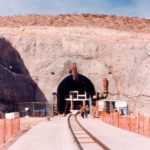 America’s ageing nuclear power plants hold over 70,000 metric tons of radioactive waste. While the Yucca Mountain Repository is almost certain to never receive any nuclear waste, it must go somewhere! And for now, that ‘somewhere’ is in a wet or dry storage facility at the nuclear power plant near you (see map below).
America’s ageing nuclear power plants hold over 70,000 metric tons of radioactive waste. While the Yucca Mountain Repository is almost certain to never receive any nuclear waste, it must go somewhere! And for now, that ‘somewhere’ is in a wet or dry storage facility at the nuclear power plant near you (see map below). The Yucca Mountain Repository was supposed to begin accepting nuclear waste from power plants in January of 1998. A series of court cases and transportation challenges caused delays through 2006, when then Senate Majority Leader Harry Reid vowed to block completion of the project. In 2008, however, the Department of Energy approved the license application for Yucca Mountain, and despite the Obama Administration’s attempt to terminate the licensing proceedings, a federal appeals court in 2013 ruled that the Nuclear Regulatory Commission (NRC) must continue its review of the license application. In 2015, the NRC completed its 5-volume Safety Evaluation Report which found the application met the regulatory requirements – with exception to certain land withdrawal and water rights. Senator Reid stated that the NRC findings only reiterate that “…the Department of Energy lacks the required land and water rights and has no reason to expect that it will obtain them in the future.”
The Yucca Mountain Repository was supposed to begin accepting nuclear waste from power plants in January of 1998. A series of court cases and transportation challenges caused delays through 2006, when then Senate Majority Leader Harry Reid vowed to block completion of the project. In 2008, however, the Department of Energy approved the license application for Yucca Mountain, and despite the Obama Administration’s attempt to terminate the licensing proceedings, a federal appeals court in 2013 ruled that the Nuclear Regulatory Commission (NRC) must continue its review of the license application. In 2015, the NRC completed its 5-volume Safety Evaluation Report which found the application met the regulatory requirements – with exception to certain land withdrawal and water rights. Senator Reid stated that the NRC findings only reiterate that “…the Department of Energy lacks the required land and water rights and has no reason to expect that it will obtain them in the future.”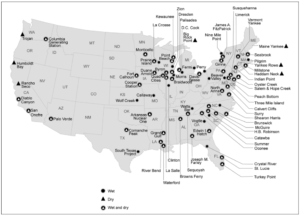


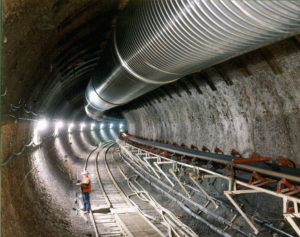

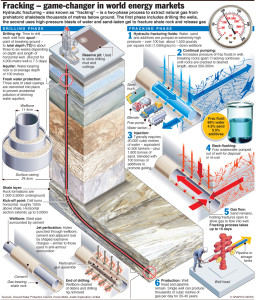

 There are a wide range of attitudes and perspectives around the issue of teachers unions, and the effects these unions have on our children’s learning. As with most political circumstances, a healthy balance of agreement and disagreement are needed in order to fully appreciate and comprehend the various sides to the issue(s) at hand. All too often, impassioned and well-meaning individuals can take a stance that is very definitive, faulting a singular source as the blame for a much larger, systemic issue – such as the case in the US gun ownership argument, for instance.
There are a wide range of attitudes and perspectives around the issue of teachers unions, and the effects these unions have on our children’s learning. As with most political circumstances, a healthy balance of agreement and disagreement are needed in order to fully appreciate and comprehend the various sides to the issue(s) at hand. All too often, impassioned and well-meaning individuals can take a stance that is very definitive, faulting a singular source as the blame for a much larger, systemic issue – such as the case in the US gun ownership argument, for instance.
 vehicle travel lanes, they should reflect on the short and long term goals of the bike network growth to determine how to best address the issues of safety and accessibility. Are painted lines truly going to protect our citizens?
vehicle travel lanes, they should reflect on the short and long term goals of the bike network growth to determine how to best address the issues of safety and accessibility. Are painted lines truly going to protect our citizens?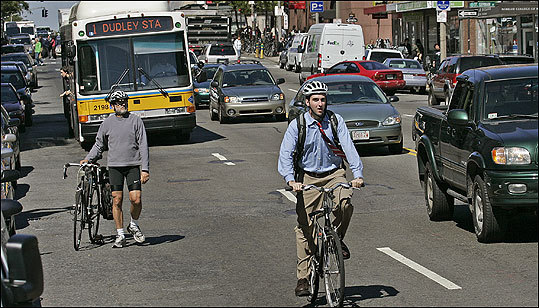 Driving in Boston streets is a difficult task, becoming increasingly complicated as cyclists take to the roads and sidewalks at will. With such a range of bicyclists, it becomes nearly impossible for drivers and pedestrians to predict the interactions and behaviors of cyclists. An auto driver must be in constant awareness of the cars around them, the pedestrians crossing the street (often at random), and the cyclists which can come from any direction and travel in any lane, at a wide range of speeds. Double parking, unpredictable lane changes, irregular driving of cabs, potholes, and many other incidents keep vehicle drivers constantly preoccupied. To expect that safer driving is within reason is a superficial and idealistic ‘solution’ to the issue.
Driving in Boston streets is a difficult task, becoming increasingly complicated as cyclists take to the roads and sidewalks at will. With such a range of bicyclists, it becomes nearly impossible for drivers and pedestrians to predict the interactions and behaviors of cyclists. An auto driver must be in constant awareness of the cars around them, the pedestrians crossing the street (often at random), and the cyclists which can come from any direction and travel in any lane, at a wide range of speeds. Double parking, unpredictable lane changes, irregular driving of cabs, potholes, and many other incidents keep vehicle drivers constantly preoccupied. To expect that safer driving is within reason is a superficial and idealistic ‘solution’ to the issue. In order to keep bicyclists safe and thus encourage higher cycling rates, physical separation from drivers is necessary. Bike paths on busy roadways provide a 30% risk improvement to roadways with parked cars and no bike infrastructure, however physical separation reduces the rate of accidents by nearly 90%.Without explaining all of the social, environmental, and financial benefits of bicycling, it is important to understand that even drivers should advocate for improved bicycling facilities in order to promote cycling; the more bikers, the less cars on the road which means less congestion for vehicles.
In order to keep bicyclists safe and thus encourage higher cycling rates, physical separation from drivers is necessary. Bike paths on busy roadways provide a 30% risk improvement to roadways with parked cars and no bike infrastructure, however physical separation reduces the rate of accidents by nearly 90%.Without explaining all of the social, environmental, and financial benefits of bicycling, it is important to understand that even drivers should advocate for improved bicycling facilities in order to promote cycling; the more bikers, the less cars on the road which means less congestion for vehicles.